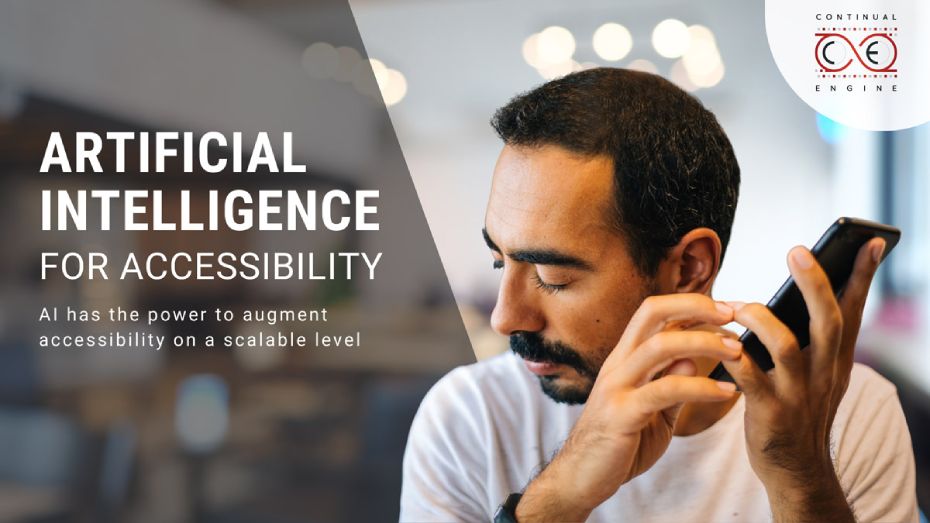Key Takeaways
- People with disabilities can drastically improve their everyday lives with AI assistive technology.
- According to a survey, less than 2% of the online content meets accessibility guidelines. For a smooth user experience with assistive technologies, the gap in digital accessibility has to be bridged.
- AI is improving assistive technology for making the web accessible for all by democratizing learning and enabling inclusive employment.
- The path to a fully accessible world depends on how AI ‘matures.’
Artificial Intelligence is more grounded in our realities than we think. It is undoubtedly a far cry from the abstract, futuristic notion of AI technology we see in Sci-fi films with humanoids and holograms. At least for now!
AI is integrated into our everyday lives. When you search for something on the internet, AI decides the top results. What you see on your social media handles is prioritized by an AI algorithm. AI-powered technologies are used worldwide across multiple industries for improved user experiences, faster analytics, and problem-solving.
Artificial Intelligence for Accessibility
Artificial Intelligence is revolutionizing accessibility and inclusion in physical and digital environments for people with disabilities. People with disabilities can drastically improve their everyday lives with AI assistive technology. For instance, Seeing AI from Microsoft combines the power of the cloud and AI to turn the visual world into an audible experience. People with visual impairments can easily read their mail, product information, and facial expressions with just the smartphone camera. However, for a smooth user experience with assistive technologies, the gap in digital accessibility has to be bridged.
AI can create digital access for people with disabilities.
At Continual Engine, we want to solve the challenges that organizations and educational institutions face in making content and programs accessible. As an accessibility solution provider, we use state-of-the-art technologies like deep learning, machine learning (ML), Natural Language Processing (NLP), and computer vision to automate accessibility.
Applications of AI in Digital Accessibility
Artificial intelligence is a broad catchall term that refers to everything from Siri to IBM’s Watson. AI refers to algorithms or machines that mimic human intelligence to perform tasks and can iteratively improve themselves based on the information they collect. AI supports assistive technologies in removing digital barriers for people with disabilities. Globally, over 1 billion people depend on assistive technology. When implemented effectively, AI can improve accuracy and user experiences with screen readers, speech recognition, voice command, voice recognition, image recognition, facial recognition, etc.
Here are a few ways AI is improving assistive technology for making the web accessible for all –
Democratizing learning
Inclusive employment
Employment involves large numbers of paperwork which can be a problem for people with visual impairment, learning disabilities, hearing impairment, or motor disabilities. For a truly inclusive work environment, it is essential to make all your paper works digital and accessible. The automation power of AI can be leveraged to remediate documents and websites accurately and scalably. Deep learning and ML enable AI technologies to learn on the go, which makes the process more precise with time.
Is AI enough for Digital Accessibility?
Undoubtedly, AI is more than abstract ideas and hypothetical applications. AI and associated technologies like deep learning, ML, and NLP are already powering tools that can broadly impact the lives of people with disabilities. Its faster turnaround time, accuracy, and scalability are revolutionary.
Invicta collaborates with AI and Subject Matter Experts.
Invicta is a cloud-based platform created to make the journey of accessibility compliance and remediation faster, more affordable, and seamless. It is an AI engine that auto-authors alt text for complex STEM and accounting images, including tables, charts, graphs, parabolas, and other diagrams. Invicta uses a non-template AI engine, i.e., it ‘learns’ and provides more precise solutions as it processes more complex data. A subject matter expert approves the results of Invicta to ensure accuracy and quality.
Invicta has been successfully adopted by leading academic publishers, including Pearsons, and top Universities in the US.
The context must never get lost in translation.
Final thoughts
Ensure that any multimedia elements included in your content are accessible. For example, providing alternative text descriptions for images and captions for videos can make your content more accessible for individuals with visual impairments.
